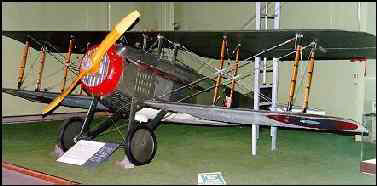 |
AIRCRAFTOF THEA E F |
Spad XI

[Spad VII shown - Spad XI was the two seat version of this aircraft.]
Development and OperationThe Spad XI was a 2-bay biplane with swept-back and positive stagger wings, but without dihedral. It was powered by a 220 hp Hispano-Suiza 8Bc engine. In many respects it appears to be a scaled-up of the Spad 7. Ailerons were on the upper wing only. A trap door was located in the floor behind the cockpit of the Observer/gunner. The pressurized fuel tank held 140 liters and there was a gravity tank in the upper wing. The oil tank held 15 liters. The pilot had a Vickers gun and the gunner a single Lewis gun. A bomb load of 70 kg could be carried. The Spad XI was considered by the STAť to be inadequate as a 2-seat fighter. It was therefore decided to purchase the Spad XI as an Army Cooperation machine to replace the A.R. 1 and Sopwith 1A2. |
Aircraft and Flight Characteristics
(With the Hispano-Suiza 8Ee engine)
|
Maximum Speed |
|
|
Sea Level |
188km/hr. |
|
2000 m |
181 km/hr. |
|
4000 m |
177 km/hr. |
|
4000 m |
168 km/hr. |
|
Climb |
|
|
500 m |
1 minute 35 seconds |
|
1000 m |
3 minutes 25 seconds |
|
2000 m |
7 minutes 35 seconds |
|
4000 m |
17 minutes 30 seconds |
References:
1. French Aircraft of the First World War
by Davilla, Dr. James and Arthur M. Soltan
To find other features on the DOUGHBOY CENTER visit our
General Headquarters
For further information on the events of 1914-1918
visit the homepage of
The Great War Society
Michael E. Hanlon (medwardh@hotmail.com) regarding content,
or to Mike Iavarone (mikei@mcs.com) regarding form and function.
Original artwork & copy; © 1998, The Great War Society